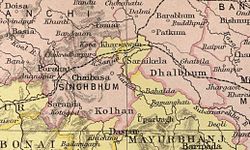| Patkum estate | |||||||||
|---|---|---|---|---|---|---|---|---|---|
| Zamindari of British India | |||||||||
| 12th century–1947 | |||||||||
 Patkum region in a 1901 map of the Imperial Gazetteer of India. | |||||||||
| Capital | Ichagarh | ||||||||
| Demonym | Patkumia | ||||||||
| History | |||||||||
• Established | 12th century | ||||||||
| 1947 | |||||||||
| |||||||||
| Today part of | Jharkhand, India | ||||||||
Patkum estate (also romanised as Patkam, Patkom and Patcoom in early record) was one of the zamindari estates of India during the period of the British Raj. It is believed that the estate was found by scion of the King Vikramaditya of Solar dynasty. During British raj it was part of Bengal presidency, composing today's Chandil, Kukru, Nimdih, Ichagarh and Kandra. Ichagarh was the capital of the state. [1] [2] [3]
Contents

